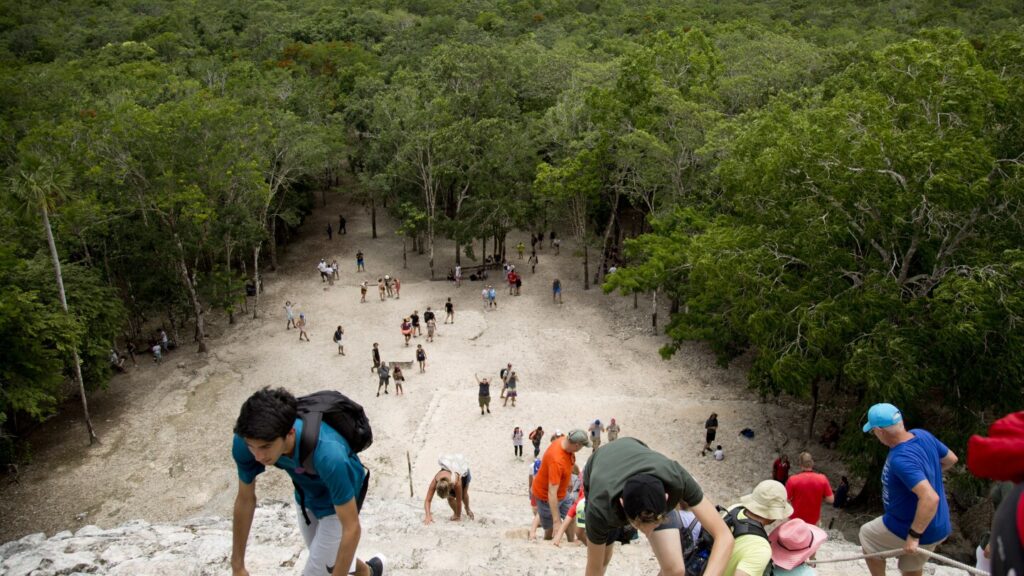GUATEMALA CITY (AP) — Mexico, Guatemala and Belize have announced plans to create a huge reserve of tropical forest spanning across the three countries. Pushing out criminal gangs and protecting the land from ranchers, miners and loggers won’t be easy.
The nature reserve announced last week and called the Great Mayan Jungle Biocultural Corridor would stretch across jungle areas of southern Mexico and northern parts of the two Central American nations, encompassing more than 14 million acres (5.7 million hectares). It would become the second largest reserve in the Americas, behind only the Amazon.
In interviews this week, the environment ministers of Mexico and Guatemala emphasized the need for security, while also expressing the intention of administrations in both countries to avoid destructive projects in the area.
“The first thing is that the security forces begin to have a presence,” because the region has been abandoned and left to organized crime, Guatemala Environment Minister Patricia Orantes said. “This is not primarily an environmental battle. We’re talking about the Guatemalan state needing to retake control of its territory.”
Environmental groups have long said that the jungle on both sides of the Mexico-Guatemala border is dotted with clandestine landing strips for cocaine-laden planes, smugglers moving migrants north and illegal loggers.
Mexico Environment Secretary Alicia Bárcena said that all three countries will need to boost their security presence in the reserve. “We’re not going to protect the forest ourselves, the security secretary has to help, the army,” Bárcena said.
Communities as allies
Just sending troops will likely be insufficient, as Mexico’s experience along another part of its southern border in Chiapas has shown. Organized crime has infiltrated economically-strapped communities with few options and it has been difficult to root them out.
Guatemalan lawyer and environmental activist Rafael Maldonado said it will be vital “to convert communities that are believed to participate in drug trafficking into allies of the park.”
To do that, Orantes said the government must offer economic alternatives to those residents.
One proposal from Mexico is the expansion of its “Planting Life” program, which offers landowners money to grow certain kinds of trees either for fruit or timber. The program has a $2 billion budget, Bárcena said.
But the program, which dates to ex-President Andrés Manuel López Obrador, has faced criticism. In 2021, the World Resources Institute reported that it had actually incentivized deforestation in Campeche state. Bárcena said the program is being adjusted to better meet environmental objectives.
Mexican sustainability and climate action expert Juan Carlos Franco, who works in southern Mexico, said security is crucial and requires the government to act as “guarantor.” But the work has to be carried out with civil society in the local communities, including in places where locals have found ways to coexist with the illegal activity surrounding them, he said.
“Communities oriented toward the biocultural management of the territory can overcome despite the crime, that’s the most revealing message,” he said.
No megaprojects
Another challenge will be holding governments over the long term to commitments to forgo big projects that promise economic development but threaten environmental damage, such as Mexico’s tourist rail operation, the Maya Train, which Belize is interested in extending to its territory.
Orantes, the Guatemala minister, said that Guatemalan President Bernardo Arévalo would not allow megaprojects in the reserve because when access is opened in the forest it becomes difficult to control everything that follows.
Arévalo recently declined to renew the contract of a petroleum company that had been operating for 40 years in a Guatemalan reserve known as the Maya Biosphere.
Guatemala is making the largest land contribution to the reserve, encompassing 27 existing protected areas. Arévalo had already made clear that he would not run an extension of the Maya Train proposed by Mexico’s last president through protected areas.
In Mexico, Bárcena noted that the 950-mile (1,500-kilometer) train line, which started running in late 2023 and goes in a rough loop around the Yucatan Peninsula, lies outside the new reserve’s territory.
She said her agency was working to alleviate some of the environmental impacts of the train line, in collaboration with companies operated by the Mexican Army, which built a large portion of the rail line and operates the train.
To avoid destructive projects in the new reserve, the three governments agreed to create a council made up of environmental authorities, as well as an Indigenous advisory council, Bárcena said. Any proposed projects in the reserve would have to pass through them.
Some Mexican activists, like Pedro Uc who lives in the Yucatan, remain skeptical of the government’s commitment to conservation considering the same political party that brought the Maya Train remains in power in Mexico. Others like Franco are willing to move ahead and keep the pressure on the three governments to maintain their commitments.
This week, Mexico, Guatemala and Belize formed a committee to build a roadmap for the reserve over the next month to define which institutions will be involved, how they participate and how the project is funded, Bárcena said.
She believes they’ll be able to pull together about $6 million to get started.
Orantes, her Guatemalan counterpart, laid out the intention: “We don’t want it to be just anything there, we don’t want it to be an international cooperation agenda, nor a business agenda. We want it to be the Maya forest agenda.”
__
Verza reported from Mexico City.

